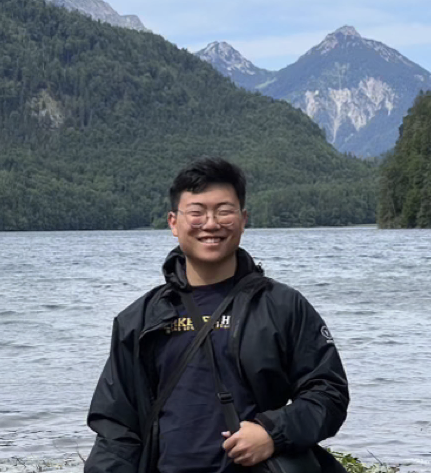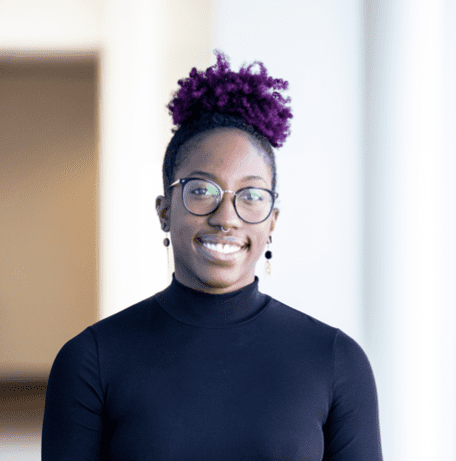Humans of Haas: Clark Kellogg
Passing Haas courtyard last Wednesday morning, it wasn’t hard to notice groups of student artists kneeling on the ground with chalk in hands, surrounded by colorful and beautiful designs. They were students from UGBA 190T, “Sustainability, Art, and Business,” led by professor Clark Kellogg, an architect, practicing studio artist, and Faculty Director of the Innovation, Creativity & Design Practice at Haas. He’s been teaching design thinking in the architecture school, and in 2011, he was invited to do the same thing here at Haas – inspire people to approach problems in less linear, more inclusive, and often human centered ways. At Haas Kellogg teaches “Creativity Lab”, “Art and Business”, and “Sustainability, Art, and Business” with the intention to bring about several playful but insightful pop up events during the semester.
As a student of “Sustainability, Art, and Business” class, I participated in the “Chalk Talk” pop up project. I was honored to talk with professor Clark Kellogg about all the behind the scenes insights, just the day before this refreshing event took place.

How do you think sustainability, art, and business are related?
On the surface, they relate in three ways. The first is for business leaders. One of the most critical shortcomings, as reported to our Dean, is that the leaders in the companies seek “more creative thinkers.” Leaders are often disappointed in the orthodoxies within which people manage or lead. So, on a very basic level, immersing oneself in creative practices is a good training ground for business leadership.
The second dimension, perhaps more obvious, is the relationship between sustainability and business. Most of our sustainability issues and solutions are rooted in either business or government. It’s almost common sense that we have to prepare our leaders to be sensitive to and aware of sustainability, moving the commercial enterprises to work more sustainable practices.
But there’s the third connection: art, business and sustainability. What does this really mean? In forming the course, I took a look at historical movements, and also at the influence of artists in social, political, and even economic movements. If we look at the response of artists to WWI, WWII, or any conflict, we see such powerful messages. I suppose the most famous art about war is Picasso’s remarkable piece called Guernica, depicting the horrors of the war in Spain. Moving forward, we see the influence of art in the social movements of the 1960s. Today, we see sustainability and art converging as artists depict both the difficulty and the promise of moving toward a sustainable future. Artists and art have typically been on the leading edge of thinking, like the canary in the mineshaft or the advance scouts for movements that will occur in society or business. By looking through the lens of art to sustainability, we are able to use the artist’s eyes and heart as an advanced sensing device for where the rest of the society will be going in a short amount of time.

What are the motivations and intentions behind the Chalk Talk project?
The class “Sustainability, Art, and Business” was created with the idea that we can ignite a new conversation about sustainability among our Haas community. Art is in play because it’s a new way to think about change. Up until now, when we think or talk about sustainability, it’s usually around all the things that humans are doing wrong. It tends to be a reaction to either guilt or shame like, “Hey! We’re consuming too much! Wasting too much! Poisoning too much!” While all that is true, if the discussion about sustainability and the earth is only framed in terms of guilt and shame, we’ll never make any progress at all.
Thus, the idea of Chalk Talk is designed to expose people to a different way of seeing the issues of sustainability. Chalk is a simple thing. It cleans up easily and no harm will come from putting some sustainably sourced chalk onto the courtyard. But also, who draws on the ground with chalk? Kids do. We associate “chalk on the sidewalk” with “children at play”, and what better metaphor could we have than people at play working on these profoundly important issues? It’s a very innocent media which allows people to bring a spirit of play to seeing and engaging in the work. Hopefully, older kids drawing with chalk will inspire a positive response of, “Ha! That’s delightful!” Now, that might happen, or it might turn out that people are angry because the student artists are getting in the way or messing up the courtyard. Who knows? But that’s one of the joys of creating an experience like this!

What are some highlights of the project?
I’ll share one happening in our class the week before Chalk Talk actually took place. I’d brought some chalk and paper into the lab where we work, suggesting that we draw a few chalk drawings just to see what happened. You know, all good art is the result of a lot of attempts before that last edition was made. We have to iterate, or learn our way into it. So the student began working, and at the end of the class, we had a little presentation. I tried not to show this, but it brought me to tears. There was so much beauty. The stories from the students were profound. I was quite delighted and surprised, not because I thought our students weren’t creative or capable, but because of the depth, intensity, and beauty of what I saw in these simple chalk drawings.
To see more details about what students did on class preparation day, read Classified: Using data and art to inspire conversations about climate change by Kim Girard.

Is there any broader picture beyond Chalk Talk that you want students or spectators to take away or think through?
When I was an architecture student here on campus many years ago, all of the issues we’re now living with were predicted by the wise people of that era. Nothing that has occurred in our current climate conversation was not known thirty or forty years ago. What that says to me is: Whatever we’re doing, if we just do it harder, it’s not going to make much of a difference. We do need a new way of thinking, relating, behaving, and acting around the issue of sustainability.
The driving hypothesis is that we can reframe the human response to sustainable issues with art and joy. Again, away from shame and guilt. Art allows people to understand things using a different part of the sensing mechanism. In this case, the prefrontal cortex where we create visual expression and understand it. That’s a very different spot of our brain than the part receiving the gloom and doom story. We are still investigating these ideas, but perhaps by using the medium of art, we can open people’s hearts enough that in fact the story will travel through the heart into the brain and allow people to begin to think a little bit differently about the work in hand. This isn’t to say that we can smile our way into survival, but I do believe that through the medium of creative fulfillment and expression, we can adjust people’s thinking to be more collaborative with the scientists, to be more accepting of the reality we’re in, and to engage themselves in the work of converting to a sustainable planet with a different mindset.
For example, right now in Berkeley, we’re experiencing a pretty severe drought or shortage of water. We can go home, feeling badly about taking a shower or running the water to do our dishes or water plants. Or, we can look at this as an opportunity to be clever, to be creative in how we value water and how we use it. It enables us to be the clever kind of problem solvers humans are. The thing we have control over and can change most easily is our mind. By focusing ourselves on our behaviors and ways of thinking, we can convert that mindset of scarcity and fear to the mindset of abundant and joyful work on solving the crisis. Hopefully, and this is a long-term big idea, humans will be able to heal the earth with joy.
But, you know, it’s really not about saving the earth. The earth will go on long after we have perished. It’s about saving ourselves. That is a profoundly positive and necessary goal should we continue to enjoy what life on earth provides. It’s also the responsibility for all of us to seek new ways of relating to and engaging in solving these issues. Of course, it only matters if we want to go on living.

According to Kellogg, after “Chalk Talk”, there will be at least one other Haaswide pop up event. And at the end of the semester, he will invite the public to a gallery featuring students’ work. Being part of the creative community, the class tends to evolve their work from time to time. So, it’ll be a great joy to see what happens next and how society will approach sustainability issues with a whole new mindset!


